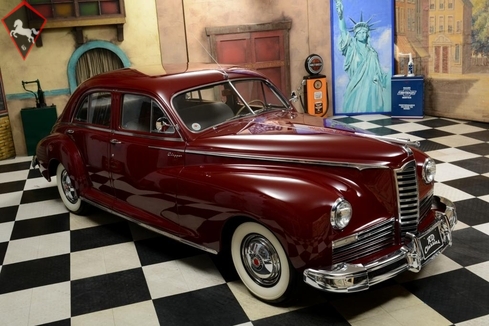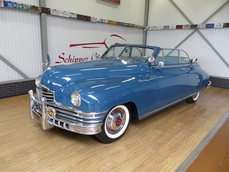Packard Clipper Series 2100 1947
General description :
Dies ist ein sehr schÃner Packard aus 1947 in einer guten Kondition.
Der Packard hat hier und dar ein wenig Patina aber trotzdem ein sehr schÃnes Fahrzeug.
Mit viel Chrom und eine schÃne zeitgenÃssische Lackierung ist der Packard ein typisches schÃnes und klassisches Fahrzeug.
Der 6-Zylinder reihen Motor lÃuft ausgezeichnet und ruhig.
Die Lackierung ist in einer guten Kondition und das Chrom ebenso.
TÃœV/H-Zulassungsabnahme gg. Aufpreis mÃglich.
Wir kÃnnen Ihnen auch TransportmÃglichkeiten anbieten.
http://www.rdclassics.com/oldtimer/1947_Packard_Clipper__Series_2100_kaufen_DE_2245.html?oldtimer=2245&taal=DE
1947 Packard Clipper Series 2100 is listed sold on ClassicDigest in Emmerich am Rhein by RD Classics for Not priced.
Car Facts
Car type : Car Make : Packard Model : Clipper Model Version : Series 2100 Engine size : 0.0 Model Year : 1947 Sub type : Sedan Location : Emmerich
Sold
Seller Information
Sold
People who viewed this Packard Clipper also viewed similar Packard listed at ClassicDigest
Other cars listed for sale by this dealer
About Packard
Packard: A Comprehensive HistoryEarly Years and Foundation:
Founding: The Packard Motor Car Company was established in 1899 in Warren, Ohio, by James Ward Packard, William Doud Packard, and George Lewis Weiss.
Pioneering Luxury: Initially producing high-quality automobiles, Packard became synonymous with luxury, craftsmanship, and engineering excellence.
Notable Achievements and Contributions:
Packard Twin Six: Introduced in 1916, this V12-powered car established Packard as a premier luxury automobile brand.
Model Line Expansion: Packard expanded its lineup with various models, including sedans, coupes, convertibles, and limousines, catering to affluent customers seeking elegance and performance.
Engineering Innovations: The brand introduced several innovations, such as the first use of aluminum pistons, air conditioning, and the Ultramatic automatic transmission.
Ten Historically Significant Models with Technical Specifications:
Packard Twin Six (1916):
Engine: 7.3L V12 engine.
Performance: Around 85 horsepower.
Packard Eight (1930-1938):
Engine: Straight-8 engine with various displacements.
Performance: Ranged from 90 to over 130 horsepower.
Packard Super Eight (1939-1951):
Engine: Straight-8 engine.
Performance: Produced between 130 to 180 horsepower.
Packard One-Twenty (1935-1942):
Engine: Straight-8 engine.
Performance: Approximately 100 to 120 horsepower.
Packard Clipper (1941-1957):
Engine: V8 engine.
Performance: Ranging from 135 to 185 horsepower.
Packard Caribbean (1953-1956):
Engine: V8 engine.
Performance: Varying between 275 to 310 horsepower.
Packard Patrician (1951-1956):
Engine: Inline-8 and V8 engines.
Performance: Ranged from 150 to 180 horsepower.
Packard Hawk (1958):
Engine: V8 engine.
Performance: Produced around 275 horsepower.
Packard Executive (1956-1958):
Engine: V8 engine.
Performance: Varying between 240 to 290 horsepower.
Packard Predictor (1956):
Engine: Concept car showcasing design and technology.
Performance: Prototype model.
Legacy and Influence:
Quality and Elegance: Packard was revered for its exceptional build quality, refined styling, and luxury features, often considered on par with European luxury brands like Mercedes-Benz.
End of Production: The brand faced financial struggles in the 1950s, leading to its merger with Studebaker and eventual discontinuation in the late 1950s, marking the end of an era in American luxury automobiles.
Packard left an enduring legacy in the automotive industry, symbolizing elegance, engineering excellence, and a commitment to luxury that has been admired and respected by car enthusiasts worldwide.























